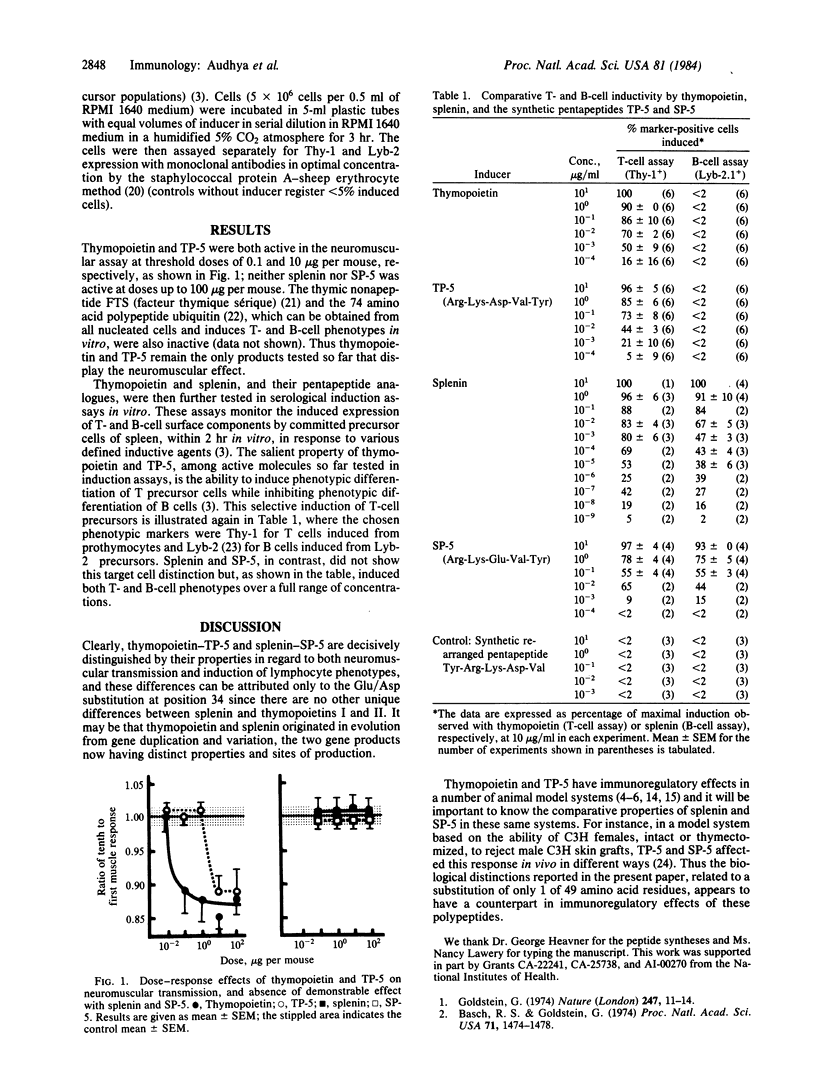Abstract
Thymopoietin, a 49 amino acid polypeptide hormone of the thymus discovered by its effect on neuromuscular transmission, was later shown to induce T-cell differentiation and to affect immunoregulatory balance. A radioimmunoassay for thymopoietin revealed a crossreaction with a product found in spleen and lymph node but not other tissues. This product, named splenin, differs from thymopoietin only in position 34, aspartic acid for bovine thymopoietin and glutamic acid for bovine splenin. Synthetic pentapeptides corresponding to residues 32-36, called thymopentin and splenopentin, reproduce biological activities of thymopoietin and splenin, respectively. Thus thymopoietin and thymopentin affect neuromuscular transmission and induce the phenotypic differentiation of T precursor cells in vitro while inhibiting phenotypic differentiation of B cells. Splenin and splenopentin, in contrast, do not affect neuromuscular transmission, and they induce both T- and B-cell precursors.
Full text
PDF


Selected References
These references are in PubMed. This may not be the complete list of references from this article.
- Audhya T., Schlesinger D. H., Goldstein G. Complete amino acid sequences of bovine thymopoietins I, II, and III: closely homologous polypeptides. Biochemistry. 1981 Oct 13;20(21):6195–6200. doi: 10.1021/bi00524a044. [DOI] [PubMed] [Google Scholar]
- Bach J., Bardenne M., Pleau J., Rosa J. Biochemical characterisation of a serum thymic factor. Nature. 1977 Mar 3;266(5597):55–57. doi: 10.1038/266055a0. [DOI] [PubMed] [Google Scholar]
- Basch R. S., Goldstein G. Induction of T-cell differentiation in vitro by thymin, a purified polypeptide hormone of the thymus. Proc Natl Acad Sci U S A. 1974 Apr;71(4):1474–1478. doi: 10.1073/pnas.71.4.1474. [DOI] [PMC free article] [PubMed] [Google Scholar]
- Goldberg E. H., Goldstein G., Boyse E. A., Scheid M. P. Effect of the TP5 analogue of thymopoietin on the rejection of male skin by aged and thymectomized female mice. Immunogenetics. 1981;13(3):201–204. doi: 10.1007/BF00350786. [DOI] [PubMed] [Google Scholar]
- Goldstein G., Hofmann W. W. Electrophysiological changes similar to those of myasthenia gravis in rats with experimental autoimmune thymitis. J Neurol Neurosurg Psychiatry. 1968 Oct;31(5):453–459. doi: 10.1136/jnnp.31.5.453. [DOI] [PMC free article] [PubMed] [Google Scholar]
- Goldstein G., Hofmann W. W. Endocrine function of the thymus affecting neuromuscular transmission. Clin Exp Immunol. 1969 Feb;4(2):181–189. [PMC free article] [PubMed] [Google Scholar]
- Goldstein G. Isolation of bovine thymin: a polypeptide hormone of the thymus. Nature. 1974 Jan 4;247(5435):11–14. doi: 10.1038/247011a0. [DOI] [PubMed] [Google Scholar]
- Goldstein G. Radioimmunoassay for thymopoietin. J Immunol. 1976 Aug;117(2):690–692. [PubMed] [Google Scholar]
- Goldstein G., Scheid M. P., Boyse E. A., Schlesinger D. H., Van Wauwe J. A synthetic pentapeptide with biological activity characteristic of the thymic hormone thymopoietin. Science. 1979 Jun 22;204(4399):1309–1310. doi: 10.1126/science.451537. [DOI] [PubMed] [Google Scholar]
- Goldstein G., Scheid M., Hammerling U., Schlesinger D. H., Niall H. D., Boyse E. A. Isolation of a polypeptide that has lymphocyte-differentiating properties and is probably represented universally in living cells. Proc Natl Acad Sci U S A. 1975 Jan;72(1):11–15. doi: 10.1073/pnas.72.1.11. [DOI] [PMC free article] [PubMed] [Google Scholar]
- Goldstein G. The thymus and neuromuscular function. A substance in thymus which causes myositis and myasthenic neuromuscular block in guineapigs. Lancet. 1968 Jul 20;2(7560):119–122. doi: 10.1016/s0140-6736(68)90414-5. [DOI] [PubMed] [Google Scholar]
- Goldstein G. Thymitis and myasthenia gravis. Lancet. 1966 Nov 26;2(7474):1164–1167. doi: 10.1016/s0140-6736(66)90479-x. [DOI] [PubMed] [Google Scholar]
- Goldstein G., Whittingham S. Experimental autoimmune thymitis. An animal model of human myasthenia gravis. Lancet. 1966 Aug 6;2(7458):315–318. doi: 10.1016/s0140-6736(66)92599-2. [DOI] [PubMed] [Google Scholar]
- Lau C. Y., Freestone J. A., Goldstein G. Effect of thymopoietin pentapeptide (TP5) on autoimmunity. I. TP5 suppression of induced erythrocyte autoantibodies in C3H mice. J Immunol. 1980 Oct;125(4):1634–1638. [PubMed] [Google Scholar]
- Lau C. Y., Wang E. Y., Goldstein G. Studies of thymopoietin pentapeptide (TP5) on experimental tumors. I. TP5 relieves immunosuppression in tumor-bearing mice. Cell Immunol. 1982 Jan 15;66(2):217–232. doi: 10.1016/0008-8749(82)90174-5. [DOI] [PubMed] [Google Scholar]
- Ranges G. E., Goldstein G., Boyse E. A., Schield M. P. T cell development in normal and thymopentin-treated nude mice. J Exp Med. 1982 Oct 1;156(4):1057–1064. doi: 10.1084/jem.156.4.1057. [DOI] [PMC free article] [PubMed] [Google Scholar]
- Schedi M. P., Goldstein G., Boyce E. A. Differentiation of T cells in nude mice. Science. 1975 Dec 19;190(4220):1211–1213. [PubMed] [Google Scholar]
- Scheid M. P., Goldstein G., Boyse E. A. The generation and regulation of lymphocyte populations: evidence from differentiative induction systems in vitro. J Exp Med. 1978 Jun 1;147(6):1727–1743. doi: 10.1084/jem.147.6.1727. [DOI] [PMC free article] [PubMed] [Google Scholar]
- Weksler M. C., Innes J. D., Goldstein G. Immunological studies of aging. IV. The contribution of thymic involution to the immune deficiencies of aging mice and reversal with thymopoietin32-36. J Exp Med. 1978 Oct 1;148(4):996–1006. doi: 10.1084/jem.148.4.996. [DOI] [PMC free article] [PubMed] [Google Scholar]


